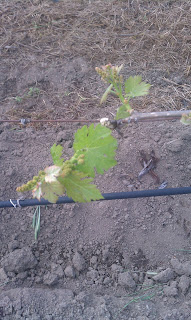Hello all Happy Monday. It is June and thus the beginning of summer. Always a great time to get out and explore, visit wine regions and enjoy the art of wine tasting, or the skill of wine consumption depending on your philosophy. I always encourage people in Northern California to be grateful and take advantage of all the fantastic wine and beautiful scenery of the vineyards we are surrounded with.
With that being said today I wanted to take a little time to share a recent evening hosted at SPQR Restaurant in San Francisco. This is where I am currently employed and without a doubt enjoying the opportunity to work and study. http://www.spqrsf.com/. We recently welcomed Paola Gloder Montefiori, the daughter of Giancarlo Gloder who originally purchased the estate. She was kind enough to share some of her fantastic wines with us.
Poggio Antico is a winery and estate located in the Montalcino region south of Siena in Tuscany. The first vines were planted in 1970, and in 1984 Giancarlo Gloder purchased the estate. The estate measures about 200 hectares, with about 32.5 hectares planted to grape vines. The majority of this is Sangiovese, here called Brunello, with a sprinkling of Cabernet Sauvignon vines which go towards a newer concept blended wine from the property. The estate is home to the highest elevation vineyards in all of Montalcino.
2009 Poggio Antico Rosso di Montalcino
This wine is the same juice as the Brunello Normale, only bottled early. There is no distinction made in the vineyard with the fruit, only in the cellar. The wine is aged for about a year in large French barrels and allowed to settle in the bottle before release.
Pale ruby in color with a medium concentration, bright red cherries and strawberries mix with a pleasant spice element which develops into warm eathenflavors on the palate. The wine is well integrated with a long plush finish. The wine to drink while the Brunello's mature.
2007 Poggio Antico Brunello di Montalcino Normale
Moving on to the Brunello Normale, which is again the same juice as the the Rosso, you begin to understand what the aging of the wine does here. Here we have 3 years in large Slavonian oak barrels before bottling and settling.
The wine shows more aging and a lower intensity of color, but the aromas have more depth. Darker cherries with warm leather begin, backed by the classic roasted wood herb aromas. Also a hint of nutmeg from the time spent in wood. The tannins are noticably bigger here, and while this wine has a long life ahead, it was very apporachable and enjoyable in its youth.
2007 Poggio Antico 'Altero' Brunello di Montalcino
"Altero,' or self-confident is a wine special to Poggio Antico. It began in 1983 as a table wine out of a want to try something different. Since its' first vintage Altero has always been aged for 2 years in French barrels, not tradtional for the production of Brunello di Montalcino. In fact it was not until the laws were revised for the aging of Brunellos that this wine was able to apply for reclassification.
The aromas take a shift, but the essence of the estate is preserved. The fruit goes darker and more black, while the spices of nutmeg and cinnamon become more dominant. Also I found more of a meaty quality to the palate which left a savory element to a very long finish. Not quite as open right now as the Normale, give it a couple years, if you can wait that long...
2006 Poggio Antico Brunello di Montalcino Riserva
The Riserva selection is sourced from a parcel of vines which were the original plantings in the early 1970's. The first year the wine is aged in French barrels, and then transferred for 2.5 years into large Slavonian oak botti (very large barrels). This allows for the best of both worlds in flavor, as well as an opportunity to soften the naturally strong tannins. This win was still very young and very tight, the tannins needing more time to unwrap themself. 2006 was an amazing year for Montalcino and this wine showed it.
Black cherry and blueberry notes were drizzled with hints of aged balsamic vinegar and again a bit of a gamey/meaty quality. The oak spices were there, but now more dressed with vanilla and lingered long after the wine was gone. Give this wine a few years and it will be even better.
2004 Poggio Antico Brunello di Montalcino Riserva
As a treat we were able to offer ethe 2004 Riserva as well, out of a magnum no less. This was my favorite of the night because of its complex sturcture and also because it had been given a little more time to fully integrate. Also a big full flavored vintage like 2006, this wine has a very long happy life ahead of it, that is if you can wait...
Cheers to All!
Jeremiah
http://www.spqrsf.com/
http://www.poggioantico.com/








